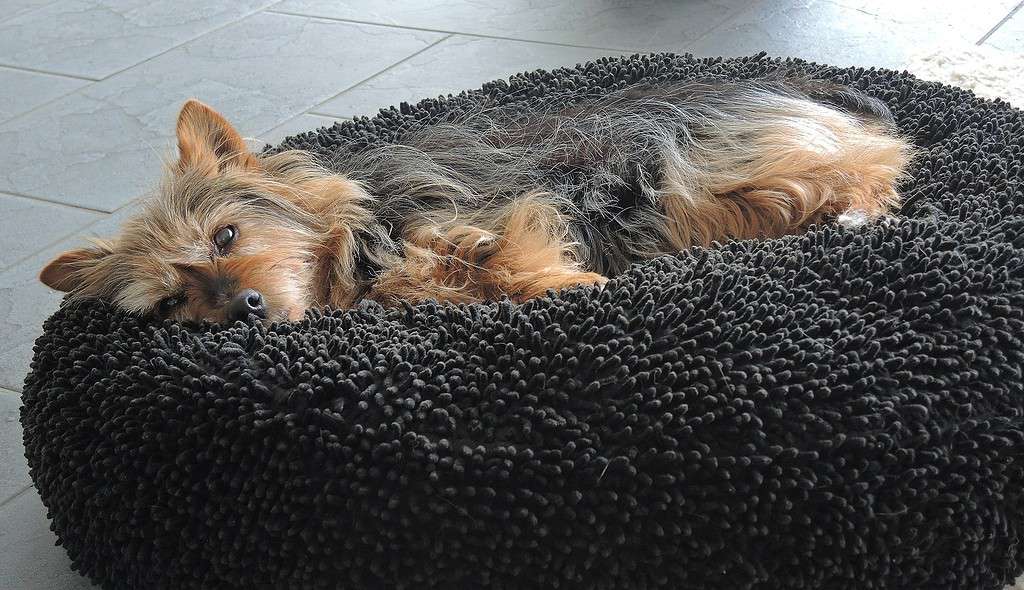
Terriers are small-breed dogs that help hunters and farmers by keeping foxes and other vermin like rats away from their fields and livestock. Most are highly energetic, excellent runners who can track and chase prey out of their burrows.
While the need for hunting and livestock protection has decreased, terriers are popular dog breeds for families to keep at home. Their small size and playful energy make them adorable family pets, with some becoming admired show dog breeds because of their coats. Two popular pet terriers are the Yorkshire (Yorkie) terrier and the Australian (Aussie) terrier.
On the surface, both of these dogs are identical with similar coat color, facial structure, and style. However, a keen eye can tell these breeds have plenty of differences. This article highlights the key differences between a Yorkie and Aussie terrier, to help pet parents determine which terrier is right for them.
Key Differences Between Yorkie and Aussie Terrier
Country of Origin

Despite both breeds being born in different locations, they both share a common ancestry.
©RnDmS/Shutterstock.com
Originally, Yorkies were called “broken-haired Scottish terriers” in 1861. Later, in 1874, the breed was renamed after the town where they were born in Yorkshire, England. Scottish farmers moved to Yorkshire to find more work. The farmers brought their dogs and bred them with other terriers to create a breed capable of hunting vermin.
As the name suggests, Aussies originate from Australia. Some reports indicate they were popular breeds in Tasmania. British farmers moving to Australia brought their dogs with them (including Yorkies) and bred them with other terriers to create the Australian terrier.
Lifespan and Size
Yorkies live 12-15 years, reach 8-9 inches tall, and weigh four to seven pounds. According to the American Kennel Club (AKC), a Yorkies is a toy breed because they weigh less than 15 pounds.
Aussies live 11-15 years, reach 9-11 inches tall, and weigh 12-16 pounds. Australian terriers are in the terrier dog group because of their name and nature of hunting.
Cost
Yorkie puppies typically cost between $600 to $2,500 to buy. The price fluctuates based on location and availability of the puppies, as well as the quality of their hair. Yorkies with long and silky hair cost more than Yorkies with shorter hair.
Aussie puppies cost between $1,300-$1,500. Pet parents do not use Australian terriers as show dogs, so the price focuses on availability, location, and paperwork indicating the health and background of the puppies.
Coat Type

Owners love grooming Yorkie terriers because their hair is long, silky, smooth, and easy to stylize.
©Seregraff/Shutterstock.com
Yorkies have a single coat with hair as opposed to fur. Hair coats are typically longer, finer, have a silky texture, and a longer growth cycle, meaning they may shed less than dogs with fur.
Aussies have double-coated fur, giving them extra protection from weather and cold temperatures. Their fur is wiry, feels rough, and is shorter and denser. Thankfully, this breed does not shed often.
Intelligence and Trainability

Yorkshire and Australian terriers have moderate intelligence with stubborn personalities.
©Lisjatina/Shutterstock.com
For context, every dog has a unique personality and quirks. While a breed standard may indicate trainability and general intelligence, it is just a guide.
Yorkies possess average intelligence and require extra time and patience with training. They are capable of learning basic commands and can grow accustomed to grooming procedures like brushing hair, nail trimming, and dental care, but it might take them longer to adjust.
Aussies have slightly above-average intelligence, making them somewhat smarter than Yorkies. They learn commands quickly and can adjust to grooming procedures. However, they can be willful and stubborn, forcing pet parents to work a little more to make them learn.
Temperament

Both breeds are excellent, but Australian terriers take more time to become familiar with strangers.
©slowmotiongli/iStock via Getty Images
Yorkies are friendly, loving, and jealous dogs. They can live with other animals like cats and dogs, but they can become jealous and demand more attention from their owners. Yorkies are good with children but can be suspicious of strangers or guests in the house. Given time, they will open up to strangers and be affectionate.
Aussies are also friendly, loving, and jealous dogs, but they do not get along as well with other animals. A family adopting an Australian terrier should keep them in a single pet home or adopt a littermate with whom they are familiar. They are not an aggressive breed, but they will become jealous of other pets and may bark at other dogs to get their parent’s attention. Aussie terriers are okay around children, but suspicious of strangers.
Grooming

Yorkshire terriers require monthly grooming to keep their hair free of knots and clean.
©Evgenia Glinskaia/iStock via Getty Images
Yorkies have high grooming requirements to keep their hair healthy. The breed needs daily brushing to prevent knots, haircuts and nail trimmings every month to prevent overgrowth, and dental care annually to prevent periodontal disease. Yorkies may develop tear stains around their eyes, which is not dangerous.
Aussies have low to moderate grooming needs because of their double-coated fur. They should be brushed daily, have their teeth cleaned annually, and have routine nail trimmings once a month. Haircuts and baths should only be performed when there is too much dirt or hair obstructing vision.
Exercise

Despite having more energy, Australian terriers like to relax on a soft bed too.
©Ketterechts / CC BY-SA 4.0 – License
Yorkies have moderate energy levels, enjoying relaxing indoors with their owners as well as running around the house. However, their smaller size and lighter hair make them susceptible to harsh weather.
Aussies have moderate to high levels of energy, requiring owners to keep a consistent schedule of exercise and walks throughout the day. Pet parents should take their Australian terriers for two or three walks daily, for 15-30 minutes each. Owners should modify the time for older dogs who do not possess stamina, keeping walks short so as not to cause muscle injury.
Health Problems

Adult terriers should be seen by a vet once a year for wellness checks, and twice a year as seniors.
©Kateryna Kukota/iStock via Getty Images
Yorkies may suffer from common diseases such as:
- Collapsing trachea: the cartilage in the trachea (windpipe) deteriorates over time, making it hard to breathe
- Luxating patella: common sports injury where the kneecap pops out of place
- Dental disease: tooth decay, plaque, gingivitis, bad breath
- Allergies: food, environmental, fleas
- Hypoglycemic: blood sugar levels are too low
- Obesity: overfeeding on constant treats and unhealthy food
- Cataracts: deterioration of the eyes
- Pancreatitis: inflammation of the pancreas from eating fatty foods or treats
Aussies may suffer from common diseases such as:
- Seizures: single instance convulsions lasting several seconds to a few minutes. Chronic seizures lead to epilepsy.
- Cruciate ligament ruptures: damage to the tissue at the knee, also known as ACL tears
- Legg-Perthes disease: the ball-shaped part of the thigh bone (femoral head) temporarily loses blood
- Allergies: food, environmental, fleas
- Obesity: overfeeding on constant treats and unhealthy food
- Ear Infections: build-up of bacteria and dirt in the ears. Can also be triggered by too much moisture in the ears after a bath
Summary
For a simple recap, here are all the key differences between a Yorkie and an Australian terrier.
| Category | Yorkie Terrier | Australian Terrier |
|---|---|---|
| Country of Origin | Yorkshire, England | Australia and Tasmania |
| Dog Group | Toy | Terrier |
| Cost | $600-$2,500 | $1,300-$1,500 |
| Lifespan | 12-15 years | 11-15 years |
| Weight | 4-7 pounds | 12-16 pounds |
| Height | 8-9 inches | 12-16 inches |
| Coat Type | Single coat – hair | Double coat – fur |
| Intelligence | Average | Slightly above average |
| Good with other animals | Yes | No (except littermates) |
| Grooming Needs | High | Moderate |
| Exercise Needs | Low-Moderate | High |
| Running Speed | 11 mph | 20 mph |
Ready to discover the top 10 cutest dog breeds in the entire world?
How about the fastest dogs, the largest dogs and those that are -- quite frankly -- just the kindest dogs on the planet? Each day, AZ Animals sends out lists just like this to our thousands of email subscribers. And the best part? It's FREE. Join today by entering your email below.
Thank you for reading! Have some feedback for us? Contact the AZ Animals editorial team.







